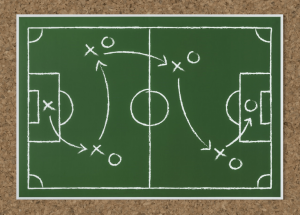Life is like a heartbeat, it has its ups and downs. Unlike a heartbeat, however, there’s no guarantee of a pattern. Sometimes we’re on the up and life is great, then it takes a turn without any warning.
While we may set ambitious targets for ourselves at work, at the end of the day, we’re all just people. People who mean so much to others, people who have stress in our lives, who get sick and who feel down at times. Life throws us obstacles along the way, which we can struggle to deal with and, sometimes, just plain ignore. However, it is important that we learn to deal with them. Not just so that we can continue to live at the pace we set for ourselves, but so that we are happy and healthy.
But how do we deal with the issues, or speed bumps, when they arise in our lives? Resilience is the key to overcoming these setbacks. Resilience has become a bit of a buzzword these days, but what does it really mean?
What is Resilience?
We all need to be resilient to get through life’s challenges. However, sometimes the concept can seem quite heavy. Let’s make it simple, you can think of resilience in terms of a car’s ability to get back to high speed after it has slowed down to avoid an obstacle. Resilience acts like a smooth gear change as we negotiate the twists and turns of life.
I like this definition of resilience.
“Resilience enables us to develop protection mechanisms against experiences which could be overwhelming. It helps us to maintain balance in our lives during difficult or stressful periods of time and it can also protect us from the development of mental health issues.”
How do you foster Resilience?
It’s all well my telling you to become more resilient because it will stand to you – but how do we actually get this resilience? I can tell you to be mindful, to be in the now or to breathe, but how do we do this?
Take a Look in the Mirror
The first step in fostering resilience is to understand how you react to stress. Only when you understand your own responses, what works well for you and what does not, can you put strategies in place to deal with it in a way that makes sense for you.
To get clear on how you respond to stress observe yourself for a month.
Ask yourself questions like:
- Am I stressed today?
- On a scale of 1-10 how stressed am/was I?
- What are the signs of this stress?
- Did I de-stress at any point during the day?
- What helped me to de-stress?
If you’re feeling brave, you could ask a loved one to tell you how you react to stress, how often they think you get stressed and what helps you to de-stress. But remember, when you ask questions like this, it doesn’t help to get reactive about the answers you get. This is all fuel to help you know yourself better. Armed with this knowledge you can put tools in place to develop your resilience.
Building Your Resilience Toolkit
The best way to develop resilience for yourself is to set out to build a resilience toolkit. This is a box of tools you can access at a moment’s notice any time you need it. We all deal with stressful situations or change differently. When you have a toolkit, built just for you, you can rest easy in the knowledge that you have whatever you need to deal with any difficult situation as it arises.
To help us de-stress some people like to read, others like to listen to music, while still others swear by exercise – feel free to include any of these in your toolkit. Other common resilience tools include practicing yoga, walking and chatting things over with good friends and family.
There are 5 specific things you can do on an ongoing basis which will help flex your resilience muscles and grow your resilience over time. Try them out and see how they work for you.
- Prioritise Building Supportive Relationships
As mentioned above, many people seek out others they trust when facing a difficult situation. The old adage ‘a problem shared is a problem halved’ is true. In our increasingly technological world, our personal relationships can suffer, whether that be with our significant other or with our wider circle of friends and work colleagues. Take time to invest in building the type of relationships that we all need when life gets tough.
If you lend them a listening ear and they lend you a shoulder, this reciprocal relationship, based on respect and empathy, can help you navigate difficulties in life as both of you become more resilient.
- Give Yourself a Break (Literally)
One of the biggest barriers to resilience is having sufficient rest. We’re not machines, if our bodies don’t get enough sleep the natural repair processes cannot take place and we end up with higher levels of the stress hormone cortisol running through our bloodstream on a daily basis.
When we are at rest, our brains have a chance to sort through the deluge of information it absorbed during the day. This helps us to come up with solutions to problems that we simply couldn’t arrive at before our brains sorted that information.
It’s not just sleep that is important either. We need to take time off, to enjoy ourselves – all work and no play makes us not only dull, but inefficient, too. Schedule that time off into your diary in regular intervals to allow yourself stress recuperation time on an on-going basis.
- Learn to Detach from the Situation
One big difference between those who are resilient and those who have yet to become resilient is their way of looking at a situation. When we are in the middle of a crisis our viewpoint tends to shrink, we focus on the minutiae of the problem and lose perspective.
When resilient people look at a potential problem, they look at the macro picture. They observe how everything fits together and can decide how big the problem really is – and then respond appropriately.
If you can remind yourself to stop when you encounter a difficulty and look at the situation as a whole it becomes easier to take a realistic, non-doomsday approach to the problem. This takes the pressure off you and allows you to deal with it more effectively.
- Watch Your Self-Talk
How we think determines our ability to make things happen. If we are positive, we will feel more capable, have more energy and persevere in the face of adversity. When we are negative, we can literally stop ourselves in our tracks before we start.
Notice the voice in your head. Does it build you up or pull you down?
If it is the latter, it’s time to make a change. Observe your thoughts, mindfulness practice can help with this. Don’t push those thoughts away, rather instigate a routine of positive self-talk.
If you’re not sure where to start, think about how you would engage with a child who is nervous about playing in a football match or performing in a school concert. We would build them up with positive reinforcement. We would remind them of the positive experiences they had the last time they did it. Talk to yourself as you would a beloved child. You don’t need to baby it down but be kind to yourself, it will help you to develop resilience – and become more successful!
- Choose Your Response
When trouble arises, whether at home or at work, we always have a choice about how to respond. Unfortunately, we don’t always see this as true. When we are in a state of stress our body almost chooses our response for us. We take the option that we see as protecting ourselves in that moment. Usually, there seem to be only two options – fight or flight. Often, neither of these responses will lead us to a satisfactory conclusion.
By lowering the level of stress hormones in your body, by implementing the other tips, you free yourself up to choose the best response to any situation. You don’t have to get into a confrontation or exit through the nearest doorway. Learn to look for secret option number three, which will be different depending on the situation.
The more comfortable you become with choosing your response, the better you will get. Your responses will become more appropriate and you will improve your ability to deal with unexpected situations. You can even give yourself a clap on the back as you see your resilience levels grow!
Developing your resilience can take time and effort, but the rewards it delivers will pay time and time again. Sometimes it helps to have a professional partner who is there to walk through such challenges with you. I work with my business and personal coaching clients to give them clarity of thought and to make sense of the jigsaw that is their lives. Contact me, Sinead, here to book your free 30-minute discovery session and take the first step towards increasing your resilience and leading a less stressful life.





